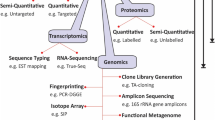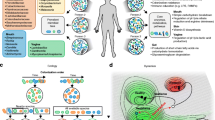Abstract
It is a well-recognized fact that the composition of human salivary microbial community is greatly affected by its nutritional environment. However, most studies are currently focused on major carbon or nitrogen sources with limited attention to trace elements like essential mineral ions. In this study, we examined the effect of iron availability on the bacterial profiles of an in vitro human salivary microbial community as iron is an essential trace element for the survival and proliferation of virtually all microorganisms. Analysis via a combination of PCR with denaturing gradient gel electrophoresis demonstrated a drastic change in species composition of an in vitro human salivary microbiota when iron was scavenged from the culture medium by addition of the iron chelator 2,2′-bipyridyl. This shift in community profile was prevented by the presence of excessive ferrous iron (Fe2+). Most interestingly, under iron deficiency, the in vitro grown salivary microbial community became dominated by several hemolytic bacterial species, including Streptococcus spp., Gemella spp., and Granulicatella spp. all of which have been implicated in infective endocarditis. These data provide evidence that iron availability can modulate host-associated oral microbial communities, resulting in a microbiota with potential clinical impact.






Similar content being viewed by others
References
Andrews S, Robinson A, Rodriguez-Quinones F (2003) Bacterial iron homeostasis. FEMS Microbiol Rev 27:215–237
Jakubovics NS, Jenkinson HF (2001) Out of the iron age: new insights into the critical role of manganese homeostasis in bacteria. Microbiology 147:1709–1718
Braun V, Killmann H (1999) Bacterial solutions to the iron-supply problem. Trends Biochem Sci 24:104–109
Braun V (2001) Iron uptake mechanisms and their regulation in pathogenic bacteria. Int J Med Microbiol 291:67–79
Ratledge C, Dover L (2000) Iron metabolism in pathogenic bacteria. Annu Rev Microbiol 54:881–941
Marx JJM (2002) Iron and infection: competition between host and microbes for a precious element. Best Pract Res Clin Haematol 15:411–426
Weinberg E (1978) Iron and infection. Microbiol Rev 42:45–66
Wooldridge K, Williams P (1993) Iron uptake mechanisms of pathogenic bacteria. FEMS Microbiol Rev 12:325–348
Finkelstein R, Sciortino C, McIntosh M (1983) Role of iron in microbe–host interactions. Rev Infect Dis 5:S759–S777
Aas JA, Paster BJ, Stokes LN, Olsen I, Dewhirst FE (2005) Defining the normal bacterial flora of the oral cavity. J Clin Microbiol 43:5721–5732
Dewhirst FE, Chen T, Izard J, Paster BJ, Tanner ACR, Yu W-H, Lakshmanan A, Wade WG (2010) The human oral microbiome. J Bacteriol 192:5002–5017
Paster BJ, Boches SK, Galvin JL, Ericson RE, Lau CN, Levanos VA, Sahasrabudhe A, Dewhirst FE (2001) Bacterial diversity in human subgingival plaque. J Bacteriol 183:3770–3783
Paster BJ, Olsen I, Aas JA, Dewhirst FE (2006) The breadth of bacterial diversity in the human periodontal pocket and other oral sites. Periodontology 2000 42:80–87
Kolenbrander PE, Palmer RJ, Periasamy S, Jakubovics NS (2010) Oral multispecies biofilm development and the key role of cell–cell distance. Nat Rev Micro 8:471–480
Kuramitsu HK, He X, Lux R, Anderson MH, Shi W (2007) Interspecies interactions within oral microbial communities. Microbiol Mol Biol Rev 71:653–670
van der Hoeven JS, de Jong M, Rogers AH, Camp P (1984) A conceptual model for the co-existence of Streptococcus spp. and Actinomyces spp. in dental plaque. J Dent Res 63:389–392
Weinberg ED (2001) Human lactoferrin: a novel therapeutic with broad spectrum potential. J Pharm Pharmacol 53:1303–1310
Lönnerdal B, Iyer S (1995) Lactoferrin: molecular structure and biological function. Annu Rev Nutr 15:93–110
Evans SL, Arceneaux JE, Byers BR, Martin ME, Aranha H (1986) Ferrous iron transport in Streptococcus mutans. J Bacteriol 168:1096–1099
Ge R, Sun X, He Q (2009) Iron acquisition by Streptococcus species: an updated review. Frontiers Biology China 4:392–401
Moelling C, Oberschlacke R, Ward P, Karijolich J, Borisova K, Bjelos N, Bergeron L (2007) Metal-dependent repression of siderophore and biofilm formation in Actinomyces naeslundii. FEMS Microbiol Lett 275:214–220
Duchesne P, Grenier D, Mayrand D (1999) Binding and utilization of human transferrin by Prevotella nigrescens. Infect Immun 67:576–580
Liu X, Olczak T, Guo H-C, Dixon DW, Genco CA (2006) Identification of amino acid residues involved in heme binding and hemoprotein utilization in the Porphyromonas gingivalis heme receptor HmuR. Infect Immun 74:1222–1232
Tian Y, He X, Torralba M, Yooseph S, Nelson KE, Lux R, McLean JS, Yu G, Shi W (2010) Using DGGE profiling to develop a novel culture medium suitable for oral microbial communities. Mol Oral Microbiol 25:357–367
He X, Wu C, Yarbrough D, Sim L, Niu G, Merritt J, Shi W, Qi F (2008) The cia operon of Streptococcus mutans encodes a unique component required for calcium-mediated autoregulation. Mol Microbiol 70:112–126
He X, Tian Y, Guo L, Lux R, Zusman D, Shi W (2010) Oral-derived bacterial flora defends its domain by recognizing and killing intruders—a molecular analysis using Escherichia coli as a model intestinal bacterium. Microb Ecol 60:655–664
Sheffield VC, Cox DR, Lerman LS, Myers RM (1989) Attachment of a 40-base-pair G + C-rich sequence (GC-clamp) to genomic DNA fragments by the polymerase chain reaction results in improved detection of single-base changes. Proc Natl Acad Sci U S A 86:232–236
He X, Tian Y, Guo L, Ano T, Lux R, Zusman D, Shi W (2010) In vitro communities derived from oral and gut microbial floras inhibit the growth of bacteria of foreign origins. Microb Ecol 60:665–676
Ray C, Ryan K (2004) In: Ryan KJ (ed) Sherris medical microbiology: an introduction to infectious diseases, 4th edn. Appleton and Lange Paramount Publishing Business and Professional Group, East Norwalk, p 237
Zhu H, Liu M, Lei B (2008) The surface protein Shr of Streptococcus pyogenes binds heme and transfers it to the streptococcal heme-binding protein Shp. BMC Microbiol 8:15
Brown JS, Gilliland SM, Holden DW (2001) A Streptococcus pneumoniae pathogenicity island encoding an ABC transporter involved in iron uptake and virulence. Mol Microbiol 40:572–585
Hopkinson BM, Barbeau K (2008) Interactive influences of iron and light limitation on phytoplankton at subsurface chlorophyll maxima in the eastern North Pacific. Limnol Oceanogr 53:1303–1318
Yang C-H, Crowley DE (2000) Rhizosphere microbial community structure in relation to root location and plant iron nutritional status. Appl Environ Microbiol 66:345–351
Jin CW, Li GX, Yu XH, Zheng SJ (2010) Plant Fe status affects the composition of siderophore-secreting microbes in the rhizosphere. Annal Bot 105:835–841
Hutchins D (2001) Response of marine bacterial community composition to iron additions in three iron-limited regimes. Limnol Oceanogr 46:1535–1545
Rose JM, Feng Y, DiTullio GR, Dunbar RB, Hare C, Lee P, Lohan M, Long M, Wo SJ, Sohst B, Tozzi S, Zhang Y, Hutchins D (2009) Synergistic effects of iron and temperature on Antarctic phytoplankton and microzooplankton assemblages. Biogeosciences 6:3131
Zimmermann MB, Chassard C, Rohner F, N’Goran EK, Nindjin C, Dostal A, Utzinger J, Ghattas H, Lacroix C, Hurrell RF (2010) The effects of iron fortification on the gut microbiota in African children: a randomized controlled trial in Côte d’Ivoire. Am J Clin Nutr 92:1406–1415
Tung SK, Teng LJ, Vaneechoutte M, Chen HM, Chang TC (2007) Identification of species of Abiotrophia, Enterococcus, Granulicatella and Streptococcus by sequence analysis of the ribosomal 16S–23S intergenic spacer region. J Med Microbiol 56:504–513
Casalta JP, Habib G, La Scola B, Drancourt M, Caus T, Raoult D (2002) Molecular diagnosis of Granulicatella elegans on the cardiac valve of a patient with culture-negative endocarditis. J Clin Microbiol 40:1845–1847
Holdeman LV, Moore WEC (1974) New genus, Coprococcus, twelve new species, and emended descriptions of four previously described species of bacteria from human feces. Int J Syst Bacteriol 24:260–277
Berger U (1961) A proposed new genus of gram-negative cocci: Gemella. Intern Bull Bacteriol Nomen Taxon 11:17–19
Frenkel A, Hirsch W (1961) Spontaneous development of L forms of streptococci requiring secretions of other bacteria or sulphydryl compounds for normal growth. Nature 191:728–730
Facklam R, Elliott JA (1995) Identification, classification, and clinical relevance of catalase-negative, gram-positive cocci, excluding the streptococci and enterococci. Clin Microbiol Rev 8:479–495
Woo PCY, Lau SKP, Fung AMY, Chiu SK, Yung RWH, Yuen KY (2003) Gemella bacteraemia characterised by 16S ribosomal RNA gene sequencing. J Clin Pathol 56:690–693
Ruoff KL (2002) Miscellaneous catalase-negative, gram-positive cocci: emerging opportunists. J Clin Microbiol 40:1129–1133
Haanpera M, Jalava J, Huovinen P, Meurman O, Rantakokko-Jalava K (2007) Identification of alpha-hemolytic streptococci by pyrosequencing the 16S rRNA gene and by use of VITEK 2. J Clin Microbiol 45:762–770
Bates CS, Montanez GE, Woods CR, Vincent RM, Eichenbaum Z (2003) Identification and characterization of a Streptococcus pyogenes operon involved in binding of hemoproteins and acquisition of Iron. Infect Immun 71:1042–1055
Nobles CL, Maresso AW (2011) The theft of host heme by Gram-positive pathogenic bacteria. Metallomics 3:788–796
Griffiths BB, McClain O (1988) The role of iron in the growth and hemolysin (streptolysin S) production in Streptococcus pyogenes. J Basic Microbio 28:427–436
Imbert M, Blondeau R (1998) On the iron requirement of lactobacilli grown in chemically defined medium. Curr Microbiol 37:64–66
Archibald FS, Fridovich I (1981) Manganese and defenses against oxygen toxicity in Lactobacillus plantarum. J Bacteriol 145:442–451
Baddour LM, Wilson WR, Bayer AS, Fowler VG, Bolger AF, Levison ME, Ferrieri P, Gerber MA, Tani LY, Gewitz MH, Tong DC, Steckelberg JM, Baltimore RS, Shulman ST, Burns JC, Falace DA, Newburger JW, Pallasch TJ, Takahashi M, Taubert KA (2005) Infective endocarditis. Circulation 111:e394–e434
Bouvet A (1995) Human endocarditis due to nutritionally variant streptococci: Streptococcus adjacens and Streptococcus defectivus. Eur Heart J 16:24–27
Ohara-Nemoto Y, Kishi K, Satho M, Tajika S, Sasaki M, Namioka A, Kimura S (2005) Infective endocarditis caused by Granulicatella elegans originating in the oral cavity. J Clin Microbiol 43:1405–1407
Stroup JS, Bransteitter BA, Reust R (2007) Infective endocarditis caused by Gemella species. Infect Dis Clin Pract 15:203–205
Yerebakan C, Westphal B, Skrabal C, Kaminski A, Ugurlucan M, Bomke A-K, Liebold A, Steinhoff G (2008) Aortic valve endocarditis due to abiotrophia defectiva: a rare etiology. WMW Wiener Medizinische Wochenschrift 158:152–155
Miller W (1890) The microorganisms of the human mouth. The local and general diseases which are caused by them. White, Philadelphia, pp 274–341
Gendron R, Grenier D, Maheu-Robert L-F (2000) The oral cavity as a reservoir of bacterial pathogens for focal infections. Microb Infect 2:897–906
La Scola B, Raoult D (1998) Molecular identification of Gemella species from three patients with endocarditis. J Clin Microbiol 36:866–871
Lainscak M, Lejko-Zupanc T, Strumbelj I, Gasparac I, Mueller-Premru M, Pirs M (2005) Infective endocarditis due to Abiotrophia defectiva: a report of two cases. J Heart Valve Dis 14:33–36
Parahitiyawa NB, Jin LJ, Leung WK, Yam WC, Samaranayake LP (2009) Microbiology of odontogenic bacteremia: beyond endocarditis. Clin Microbiol Rev 22:46–64
Acknowledgments
The study was supported by US National Institutes of Health (NIH) Grants (DE020102 and DE021108) and International Science and Technology Cooperation Program of China (2011DFA30940).
Author information
Authors and Affiliations
Corresponding author
Additional information
Renke Wang and Aida Kaplan contributed equally to the work.
Rights and permissions
About this article
Cite this article
Wang, R., Kaplan, A., Guo, L. et al. The Influence of Iron Availability on Human Salivary Microbial Community Composition. Microb Ecol 64, 152–161 (2012). https://doi.org/10.1007/s00248-012-0013-2
Received:
Accepted:
Published:
Issue Date:
DOI: https://doi.org/10.1007/s00248-012-0013-2




